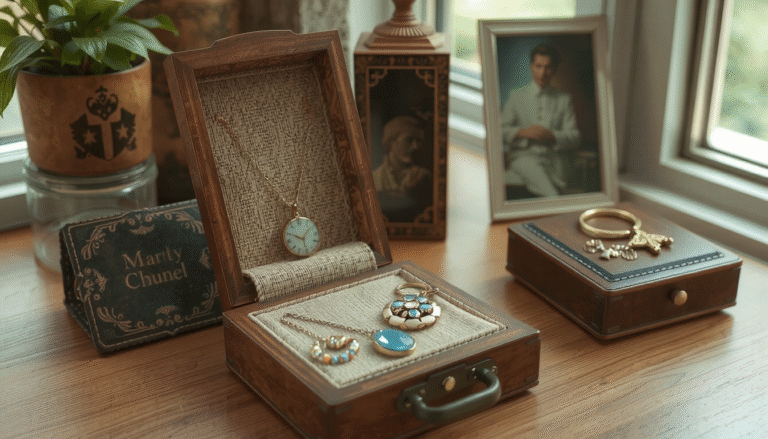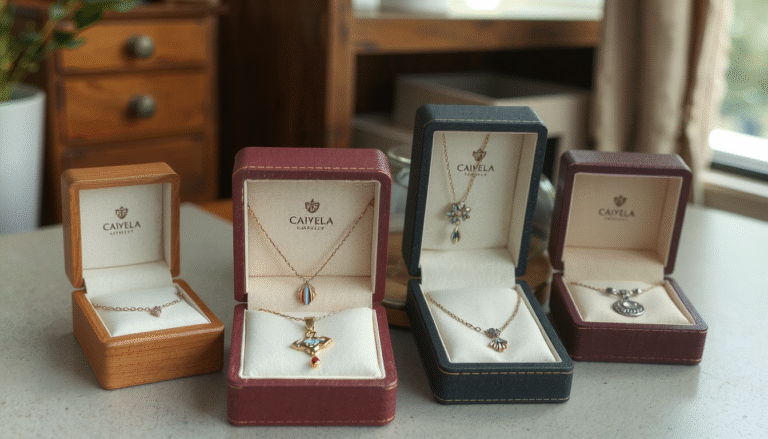A felt-lined jewelry box protects your most precious pieces. Its soft interior prevents scratches and tarnish. But that delicate felt can seem nearly impossible to clean. Many people worry about causing damage—fading the fabric, weakening the glue, or leaving water stains.
Don’t worry. We’re here to help. With proper techniques and a gentle approach, learning how to clean a felt jewelry box is both possible and simple. This complete guide covers every step. You’ll learn routine dusting, deep cleaning, stain removal, and odor elimination. Your box will look like new again, safely and effectively.
Quick Tips: Felt Cleaning Basics
- Always Test First: Before using any cleaner, test it on a hidden spot to check for color bleeding or damage.
- Use Very Little Water: Felt and its glue are sensitive to moisture. Use a barely damp cloth, never a wet one.
- Blot, Don’t Scrub: Hard rubbing damages felt fibers and causes pilling or bare spots. Gentle blotting works best.
- Let It Air Dry: Never use heat. Allow the box to air dry completely for 24-48 hours before closing it or adding jewelry back.
Getting Ready: Essential Steps Before You Clean
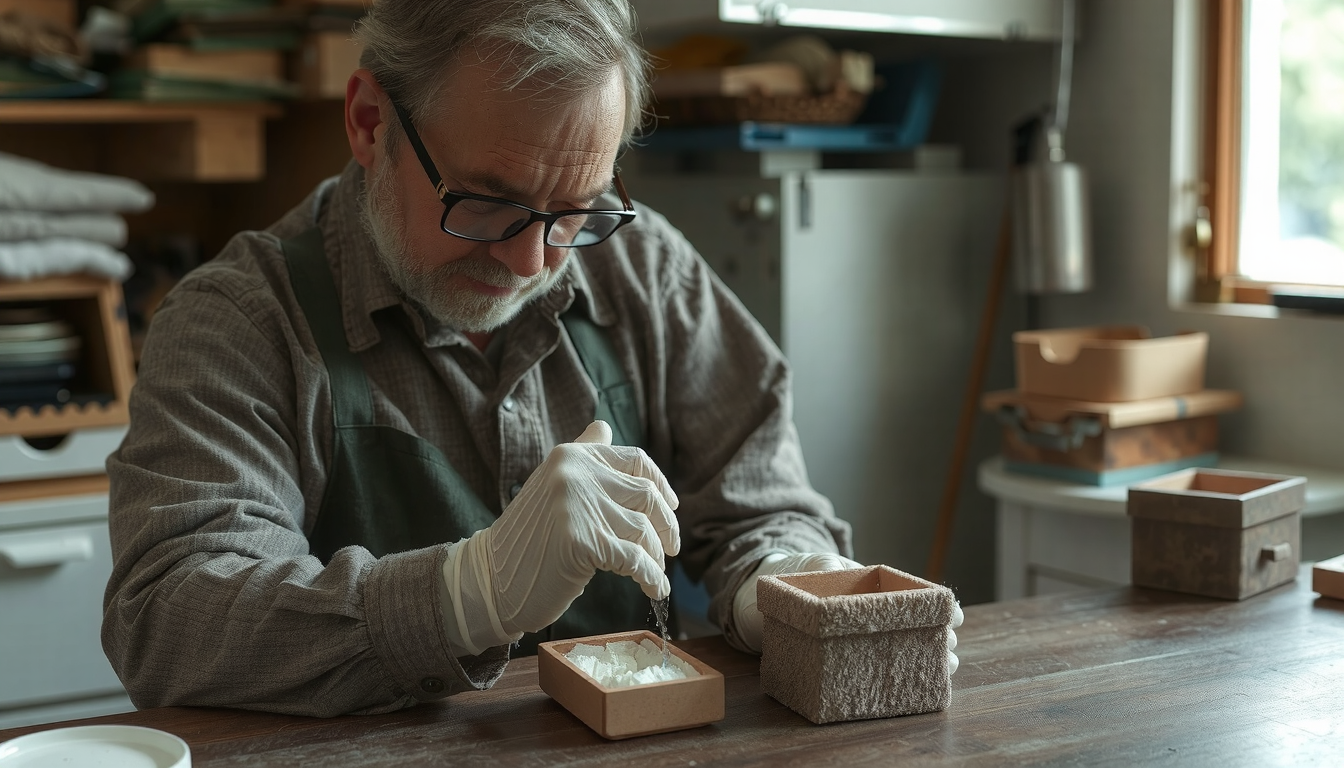
Good preparation prevents accidental damage. Take a few minutes to gather the right tools and check your jewelry box. This careful approach separates professional results from costly mistakes.
Build Your Gentle Cleaning Kit
Having the right supplies makes the job easier and safer. You probably already have most of these items at home. We suggest creating a special kit just for cleaning your felt-lined box.
For Dusting & Removing Debris:
- Soft-bristle brush (mushroom brush, new makeup brush, or soft toothbrush)
- Quality lint roller
- Handheld vacuum with soft brush attachment (use lowest setting)
- Canned air for tight spaces
For Cleaning & Stain Removal:
- Microfiber cloths
- Cotton swabs and cotton balls
- Mild, pH-neutral dish soap (clear, dye-free works best)
- Distilled water (prevents mineral spots from tap water)
- White vinegar
- Rubbing alcohol (70%)
- Optional: Quality upholstery cleaner for delicate fabrics.
Check Your Jewelry Box: Old or New?
First, figure out if your box has glued-in felt or removable parts. Removable trays or liners are often easier to clean outside the box.
Pay extra attention if you think your box is vintage. Older jewelry boxes often used water-based animal glues. Even a little moisture can dissolve this glue. This causes the felt to lift or bubble. For these pieces, always try dry methods first.
The Most Important Rule: Always Test First!
We can’t stress this enough: always test your cleaning solution first. Pick a hidden spot like inside a corner, under a removable tray, or on the lid’s underside.
Put a tiny amount of your cleaning solution on a cotton swab. Let it sit for a minute. Then gently blot with a clean, white cloth. Look for any color on the cloth, texture changes in the felt, or signs the fabric is weakening. If you see any of these, stop and use only dry-cleaning methods.
The 3-Step Method for Regular Cleaning and Dust Removal
For general upkeep or a slightly dusty box, this simple three-step process works perfectly. Regular, gentle cleaning prevents buildup that creates harder jobs later. The secret to learning how to clean a felt jewelry box well is staying consistent.
First, the essential first step: Step 0 is emptying the box completely. Carefully remove all jewelry and put it somewhere safe. This protects your valuables and gives you full access to the interior.
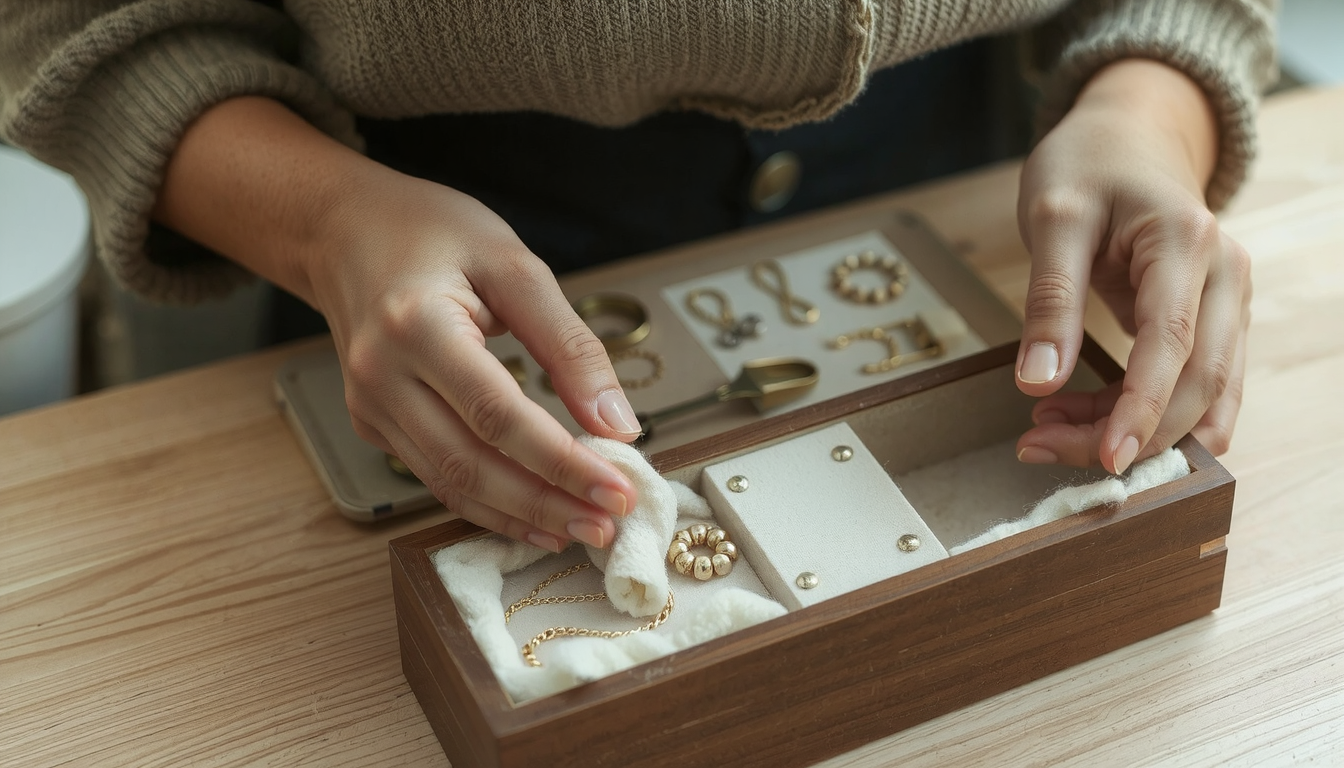
Step 1: Dry Dust Removal
Always start with dry methods. Begin with the gentlest tool and move up only if needed. A soft brush works great for corners and ring slots. A lint roller is perfect for lifting surface dust, lint, and pet hair from flat areas.
For deeper dust, try a gentle pass with a handheld vacuum’s brush attachment. Keep suction on the lowest setting. Don’t press hard—let the bristles and airflow do the work. Canned air can blow debris out of tight seams and corners.
Step 2: Gentle Wiping (If Needed)
If dry dusting doesn’t remove light surface dirt, you can try a barely damp wipe-down. This is delicate work where less is definitely more.
Make your cleaning solution by mixing a few drops of mild dish soap into a small bowl of distilled water. Dip part of a microfiber cloth into the solution. Wring it out until it’s almost completely dry. Gently blot any dirty areas—don’t rub or scrub. Right away, blot with a second cloth dampened only with distilled water to “rinse” away soap residue.
Step 3: Essential Drying and Airing
Moisture is terrible for a closed box. The felt must be completely dry before you even think about putting jewelry back. Any remaining dampness can cause musty smells, mildew growth, and tarnish on your items.
Leave the jewelry box wide open in a room with good air flow. Keep it away from direct sunlight or heat sources like radiators. These can make the felt shrink or the box warp. Be patient—allow at least 24 to 48 hours for complete air drying.
Advanced Stain Removal: A Targeted Guide for Felt
Sometimes a box has more than just dust. An ink mark, makeup smear, or mystery water ring can seem like a disaster. But with the right approach, many stains can be treated. When facing a stubborn spot, there are a few things you can try to remove them. The key is matching the cleaning method to the stain type. Always remember to test first.
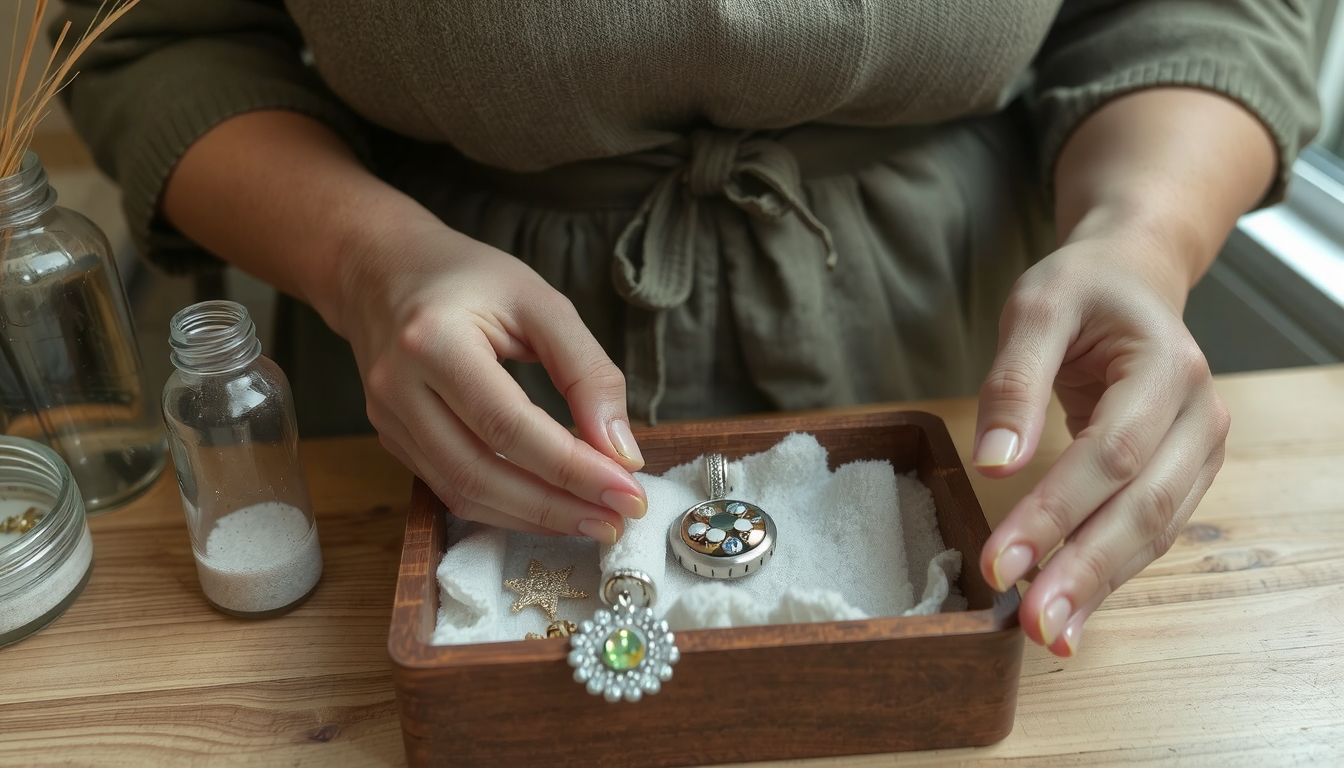
Use this chart to find the best solution for your stain. Work from the stain’s outside edge inward to prevent spreading.
| Stain Type | Best Solution | Step-by-Step Method | Important Warning |
|---|---|---|---|
| Makeup/Grease/Oil | Rubbing Alcohol (70%) | 1. Lightly dampen a cotton swab with alcohol. 2. Gently blot the stain from outside to center. 3. Use a clean part of the swab for each blot to lift the stain, not spread it. | Alcohol dries very quickly, which helps prevent soaking. Work in a well-ventilated area. |
| Water Marks/Rings | 1:1 Distilled Water & White Vinegar | 1. Lightly dampen a clean microfiber cloth with the solution. 2. Gently blot the entire felt panel evenly. This blends the stain by creating uniform dampness that dries without lines. 3. Follow by blotting with a water-only damp cloth. | This seems wrong, but it’s the professional way to remove water rings from upholstery. |
| Ink (Ballpoint) | Rubbing Alcohol or Hairspray | 1. Dab alcohol onto the stain with a cotton swab (don’t pour). If using hairspray, give a very light, quick spray. 2. Right away, blot with a clean, dry cloth. Don’t rub. 3. Repeat with fresh swabs/cloth sections until the ink lifts. | Ink stains spread very easily. A gentle, upward blotting motion is essential to lift the color out of the fibers. |
| Unknown/Old Stains | Mild Soap Solution or Upholstery Cleaner | 1. Start with the gentlest method: mild soap and distilled water solution. 2. If that doesn’t work, try a quality upholstery cleaner for delicate fabrics. Follow the product directions exactly after thorough testing. | This is your last option. Older, set-in stains are hardest to remove without professional help. |
Beyond Cleaning: Refreshing and Protecting Your Felt Jewelry Box
A truly clean jewelry box isn’t just dirt-free. It’s fresh, well-maintained, and ready to protect your collection for years. Going beyond basic cleaning ensures it lasts longer.
How to Remove Musty and Stale Smells
If your vintage or second-hand box has a lingering musty smell, don’t spray it with perfume or air freshener. This only hides the odor and adds chemicals.
Instead, use dry, absorbing materials. Place an open box of baking soda inside the jewelry box. You can also use activated charcoal packets or plain, crumpled newspaper. Close the lid and leave it for several days. These materials naturally absorb the moisture and molecules causing odors without harming the felt.
Fixing Matted or Flat Felt
After cleaning, the felt’s texture might look flat or matted. You can easily fluff it back up. Once the felt is completely dry, take a very soft brush or clean microfiber cloth. Gently brush the fibers in one direction. This lifts the texture and restores its soft, even appearance.

Long-Term Care and Maintenance
The best way to keep your box clean is prevention. A quick dusting with a soft brush or lint roller once a month prevents major buildup.
Store your jewelry box in a cool, dry place away from direct sunlight and high humidity. A bedroom closet works better than a bathroom counter. Good storage is the best prevention. For those wanting to upgrade or find a new treasure, buying a quality box from a dedicated jewelry box supplier ensures durable materials and craftsmanship that’s easier to maintain over time.
What to Avoid: 5 Mistakes That Can Ruin Felt Lining
Knowing how to clean a felt jewelry box is only half the story. Knowing what not to do is equally important for protecting your treasured item. Following proper preservation tips for delicate materials will help your box last a lifetime.
-
Never Soak the Felt. This is rule number one. Too much water can dissolve the glue holding the felt in place. This causes it to peel or bubble. It can also warp the wood or cardboard structure of the box itself.
-
Avoid Harsh Chemicals. Never use bleach, ammonia-based cleaners, or strong household detergents. These will permanently discolor, bleach, and destroy the delicate felt fibers.
-
Don’t Scrub Hard. Felt is not tough carpet. Scrubbing with a stiff brush or rough cloth will tear the fibers. This creates ugly pilling and bare patches. Always use gentle blotting or dabbing motions.
-
Stay Away from Direct Heat. Never use a hair dryer, heat gun, or place the box on a radiator to speed drying. Direct heat can shrink the felt, melt synthetic fibers, and damage the box’s finish and structure.
-
Don’t Put Jewelry Back in a Damp Box. Patience pays off. Putting your collection back in a box that’s even slightly damp spells disaster. It creates a humid environment that promotes mildew and makes metal jewelry tarnish quickly.
Frequently Asked Questions (FAQ)
Can I clean a felt jewelry box with just water?
Yes, for very light dirt, but be extremely careful. Always use distilled water to avoid mineral deposits. Use a microfiber cloth wrung out until it’s barely damp. Only blot the surface gently. The goal is using the absolute minimum moisture needed to lift the dirt.
How do I get a musty smell out of a vintage jewelry box?
Avoid liquid deodorizers completely. The most effective and safest method uses dry absorbers. Place an open container of baking soda, activated charcoal pouches, or plain, crumpled newspaper inside the box. Close the lid and let it sit for several days to a week to naturally absorb the odor.
What’s the best tool for removing stubborn lint and pet hair?
For stubborn lint and pet hair that a brush can’t remove, a quality sticky lint roller works best. For even stronger grip, wrap packing tape sticky-side-out around your fingers. Press it gently onto the felt. This lifts debris effectively without scratching the fabric surface.
Can I use a hair dryer on a low setting to dry the felt faster?
We strongly recommend against this. Even low heat settings can be too intense for delicate felt and the glues used in jewelry boxes. This can cause the felt to shrink, warp, or even melt if it’s synthetic. Natural air drying is the only truly safe method. Patience is essential for good results.
How often should I clean my felt jewelry box?
For general upkeep, light dusting or using a lint roller every one to two months prevents buildup. Deeper, damp cleaning should only happen when needed—like after a spill, noticing a specific stain, or when the box looks visibly dirty. For most boxes, this might only be once a year, if at all.



